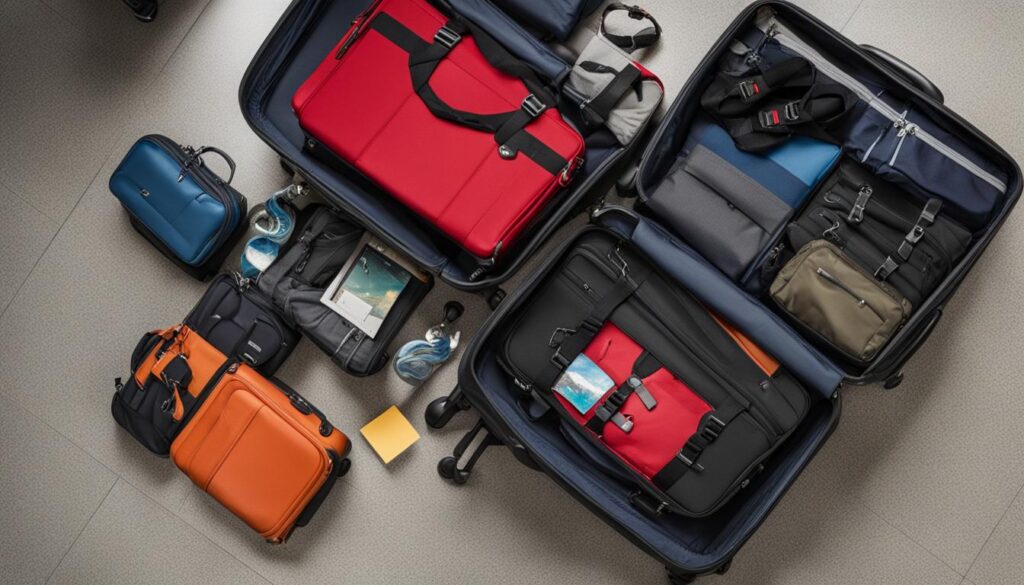Flying with climbing gear can be a stressful experience, but it doesn’t have to be. As a seasoned climber and travel enthusiast, I’ve encountered my fair share of challenges when it comes to packing and carrying climbing equipment on planes. But with the right knowledge and preparation, you can ensure a seamless and stress-free journey to your climbing destination.
In this comprehensive guide, I will share my expert tips on how to navigate the challenges of flying with climbing gear, including understanding airline rules and TSA regulations, packing your gear efficiently, and keeping it safe during transit. Whether you’re a beginner or a seasoned climber, this essential guide will provide you with all the information you need for a hassle-free travel experience.
Key Takeaways
- Understanding airline rules and TSA regulations for flying with climbing gear is crucial before embarking on your journey.
- Efficient packing techniques can save space and ensure the safety of your gear during transit.
- Knowing whether to check-in or carry-on your climbing gear depends on your specific needs and the type of equipment you are carrying.
- Protecting your climbing gear from rough handling, theft, and damage is essential during transit.
- Staying updated on airline policies and regulations can help you avoid any unexpected surprises when traveling with climbing gear.
Know the Airline Rules for Flying with Climbing Gear
If you’re planning to fly with climbing gear, it’s essential to be familiar with the rules and regulations set by the airlines and the Transportation Security Administration (TSA). Each airline has its own set of guidelines regarding the size, weight, and the number of bags allowed, and it can vary depending on your destination.
Before booking your flight, check the airline’s website for specific information on their baggage policy. Most airlines allow one carry-on bag and one personal item, such as a purse or laptop bag. However, additional fees may apply for extra luggage or oversized gear.
In addition to airline rules, the TSA has specific regulations regarding climbing gear, such as ropes, ice axes, and crampons. These regulations apply to both carry-on and checked luggage. It’s crucial to know what you can and can’t bring to avoid any complications while going through security checkpoints.
Airline Rules for Climbing Gear
When packing your climbing gear, make sure to follow the guidelines set by your airline. Here are some common rules to keep in mind:
| Item | Carry-On | Checked Luggage |
|---|---|---|
| Harness | Allowed | Allowed |
| Helmets | Allowed | Allowed |
| Rope | Allowed | Allowed |
| Crampons | Not Allowed | Allowed |
| Ice Axe | Not Allowed | Allowed |
It’s worth noting that some airlines may have additional rules or restrictions, so double-check with your airline before flying.
TSA Regulations for Climbing Gear
The TSA has specific regulations for carrying climbing gear through security checkpoints. Here are some important rules to keep in mind:
- All climbing ropes must be coiled and packed in the checked luggage. The ropes must be under 6 feet in length, and each passenger is allowed up to two ropes.
- Crampons and ice axes must be packed in checked luggage.
- All sharp objects, such as ice screws, must be packed in checked luggage.
Remember that TSA regulations can change over time, so make sure to check their website for the most up-to-date information before your flight.
By familiarizing yourself with the airline rules and TSA regulations for flying with climbing gear, you can ensure a smooth travel experience. Pack smart, follow the guidelines, and prioritize safety to enjoy your climbing adventures with peace of mind.
Packing Your Climbing Gear for Flights: Tips and Tricks
Efficiently packing your climbing gear for air travel is essential to ensuring a stress-free journey. Not only does smart packing help you avoid extra fees for overweight baggage, but it also ensures that your gear arrives in good condition at your destination. Here are some expert tips and tricks on how to pack your climbing gear for flights.
Make a Checklist
Before packing, create a checklist of all the climbing gear you need to bring. Use it as a reference when packing to ensure that you don’t forget anything important.
Use a Durable Bag
Invest in a durable bag that can withstand rough handling during transit. Choose a bag with a hard shell or a soft bag with sturdy zippers and reinforced seams.
Organize Your Gear
Keep your gear organized by using packing cubes or compression sacks. This will help maximize space and prevent items from shifting during transit.
| Item | Packing Tip |
|---|---|
| Rope | Use rope bags or stuff sacks for compact and organized storage. |
| Climbing Shoes | Pack shoes in a separate bag or wrap them in a soft cloth to prevent damage. |
| Chalk Bag | Empty chalk bags before packing to avoid making a mess in your luggage. |
| Climbing Harness | Coil your harness and pack it in a compact, flat shape to save space. |
Follow TSA Guidelines
Follow TSA guidelines when packing your climbing gear for flights. Place any sharp items, such as ice axes or crampons, in checked baggage to avoid confiscation at security checkpoints.
Pack Smart
When packing, place heavier items at the bottom of your bag and lighter items on top. This will help distribute weight evenly and prevent damage to fragile gear. Fill any empty spaces in your bag with soft items, such as clothing, to further protect your gear.
Label Your Bag
Label your bag with your name, address, and destination. This will help ensure that your bag is returned to you in case it gets lost.
Check-In vs. Carry-On: Deciding the Best Approach
When it comes to flying with climbing gear, deciding whether to check it in or carry it on can be a tough call. Both options have their advantages and disadvantages, so it’s essential to weigh them carefully to determine the best approach for your specific needs.
The Pros and Cons of Check-In
Checking in your climbing gear allows you to travel light and avoid the hassle of lugging heavy equipment around the airport. You can drop off your gear at the check-in counter and not worry about it until you arrive at your destination. However, there are some drawbacks to consider, including:
- Extra fees: Depending on the airline and your destination, you may be charged an extra fee for checked baggage, especially if it’s oversized or overweight.
- Risk of damage: Checked baggage is often subject to rough handling and may get damaged or lost during transit.
- Less control: Once you check in your gear, you don’t have any control over it until you arrive at your destination, which can be nerve-wracking for some climbers.
The Pros and Cons of Carry-On
Carrying your climbing gear on the plane allows you to keep it with you at all times and ensures that it arrives at your destination safe and sound. However, there are also some disadvantages to this approach:
- Strict regulations: The TSA has specific rules for carrying climbing gear through security checkpoints, and airlines may have their own guidelines for carry-on baggage. It’s essential to research these regulations beforehand to avoid any surprises at the airport.
- Less space: Carrying your gear on the plane means you’ll have less space for other items in your carry-on luggage.
- Heavier load: Carrying heavy climbing gear around the airport can be tiring and uncomfortable, especially if you have a lot of equipment.
Ultimately, the decision of whether to check in or carry on your climbing gear depends on your personal preferences and the nature of your equipment. If you’re traveling light and don’t want to worry about your gear during transit, checking it in may be the best option. If you have valuable gear or want to ensure that it arrives with you at your destination, carrying it on the plane may be preferable.

Understanding TSA Regulations for Climbing Gear
When it comes to flying with climbing gear, it’s important to be aware of the regulations set by the Transportation Security Administration (TSA). These regulations are designed to ensure the safety of passengers and crew during flights.
The TSA allows climbing gear in both carry-on and checked baggage, but some items may require additional screening and inspection. It’s important to properly pack your gear to facilitate this process and avoid any delays or complications.
One of the most important things to keep in mind is the rule regarding sharp objects. According to TSA regulations, any object with a blade or sharp point longer than 2.36 inches is not allowed in carry-on baggage and must be checked in. This includes things like ice axes, crampons, and knives.
If you have any liquid or gel-type items, such as chalk or sunscreen, they must be in containers that are 3.4 ounces or less and placed in a quart-sized clear plastic bag.
It’s also worth noting that some climbing equipment may be considered hazardous materials and subject to additional regulations. This includes things like fuel canisters, which must be empty and have the valve completely removed. Check with your airline for specific guidelines and restrictions regarding hazardous materials.
“By following TSA regulations for climbing gear, you can ensure a smooth security screening process and avoid any issues that may jeopardize your flight.”
While it may seem daunting to understand all the regulations, following these guidelines will help you navigate security screening with ease. By packing your gear correctly and being proactive in your approach, you can avoid any last-minute surprises and ensure a hassle-free flying experience.
Essential Gear for Climbing: What You Can and Can’t Bring
When it comes to flying with climbing gear, it’s essential to understand what gear is permitted in the cabin and what must be checked in. Each airline has its own set of rules, so it’s crucial to double-check with your airline before you start packing.
Here’s a breakdown of the allowed and restricted climbing gear:
| Allowed in Cabin | Must be Checked In | Restricted |
|---|---|---|
|
|
|
It’s crucial to note that TSA regulations also apply to climbing gear. Any restricted items will not be allowed through security checkpoints and may be confiscated. It’s also worth mentioning that some airlines may have additional restrictions or requirements, such as using specific bags for checked-in equipment.
By understanding what you can and can’t bring, you can pack your climbing gear accordingly and avoid any last-minute complications at the airport.
Protecting Your Climbing Gear During Transit
Ensuring the safety of your climbing gear during transit is crucial to maintain its integrity. Here are some valuable tips that can help you secure your gear:
- Pack Smart: Use a sturdy bag, preferably a hardshell case, to protect your climbing gear from any damage during transit. Wrap delicate items in soft materials like clothes or bubble wrap to prevent scratches or any form of damage. Arrange your gear in an organized manner to minimize the risk of items shifting or colliding during transit.
- Label Your Gear: Clearly labeling your gear will help the airline staff identify it, minimizing the risk of it getting lost or misplaced. Include your name, contact information, and destination in your labels to help reunite you with your gear in case of any mishaps during transit.
- Consider Insurance: Investing in travel insurance can be a wise move when it comes to protecting your gear. In case of loss, theft, or damage, you’ll be covered and can replace your gear without incurring any additional expenses.
- Check the Airline Regulations: Familiarize yourself with the airline’s rules and restrictions on packing climbing gear for flights. Some airlines may have specific guidelines regarding the kind of gear allowed on board or the weight and dimension of the bags. Compliance with these regulations will ensure a smooth check-in process and minimize the risk of your gear being rejected.
- Be Mindful of TSA Restrictions: While the TSA has specific guidelines for carrying climbing gear through checkpoints, these regulations may differ from airline regulations. Make sure you know both sets of rules to ensure full compliance with the airline and TSA regulations.
- Use TSA-Approved Locks: TSA-approved locks can be used to lock your bag. If the TSA requires to inspect your bag, they can open the lock with a master key and lock the bag again after inspection. This will help to secure your luggage from theft and damages.
By using these tips, you can protect your valuable climbing gear and arrive at your destination with confidence. Remember to always prioritize the safety and protection of your gear, and take extra precautions to safeguard it during transit.

Dealing with Oversized or Heavy Climbing Gear
If you’re planning to fly with oversized or heavy climbing gear, it’s important to understand the airline’s baggage policies. Most airlines have weight and size restrictions for checked and carry-on baggage, which may apply to specific types of equipment, such as ropes, harnesses, and ice axes.
When carrying climbing gear on a plane, you may have to pay extra fees for oversized or overweight baggage. Make sure to check with your airline in advance to avoid any surprises at the airport. It’s also essential to pack your gear securely to prevent damage during transit.
| Airline | Oversized baggage fee | Overweight baggage fee |
|---|---|---|
| American Airlines | $200 per item | $100 per item |
| Delta | $200 per item | $100-$200 per item depending on weight |
| United Airlines | $200 per item | $100-$200 per item depending on weight |
Documentation may be required for specific items, such as mountaineering equipment or ice tools. Make sure to check with your airline to ensure compliance with their policies and regulations.
Another option is to rent or purchase gear at your destination. This can help you avoid the hassle and expense of transporting oversized or heavy gear, while also reducing the risk of damage during transit. Just make sure to research rental options and reserve in advance, as availability may be limited.
By following these tips and researching your airline’s policies and regulations, you can successfully navigate the challenges of carrying climbing gear on a plane. Don’t let equipment size or weight hold you back from your climbing adventures!
Staying Updated on Airline Policies and Regulations
As we all know, airline rules and regulations can change without prior notice. That’s why it’s crucial to stay updated on any modifications that may affect the way you travel with your climbing gear. Here are some tips for keeping yourself informed:
- Check the airline’s website frequently for any updates to their baggage policies.
- Sign up for email alerts from the airline, so you receive notifications about any changes or promotions that may be relevant to you.
- Follow the airline’s social media accounts, as they may post important updates there as well.
- Consult with other climbers or members of climbing communities to stay informed about their recent experiences flying with climbing gear.
By staying informed, you can avoid any last-minute surprises at the airport and ensure a smooth travel experience. Remember, compliance with airline rules for climbing gear is essential, so prioritize understanding and following these regulations.
Conclusion
As a seasoned climber, I understand the challenges of flying with climbing gear. However, with the right knowledge and preparation, you can simplify the process and reduce the stress of air travel.
Stay Informed
Make sure to stay informed about airline policies and regulations for flying with climbing gear. Airlines may change their policies, so it’s essential to stay up-to-date with reliable sources of information.
Plan Ahead
Plan ahead to ensure your climbing gear is properly packed and protected during transit. Use efficient packing techniques and padding to safeguard your equipment.
Know the Rules
Understanding airline rules and TSA regulations is crucial to avoiding any surprises at the airport. Check-in with the airline and review their guidelines for bringing climbing gear on board.
Choose Wisely
Deciding whether to check-in or carry-on your climbing gear depends on your specific needs and the nature of your equipment. Weigh the pros and cons of each option and choose the most suitable approach.
By following these tips and tricks, you can master the art of flying with climbing gear. Remember to prioritize the safety and protection of your gear throughout the journey, and enjoy your climbing adventures with peace of mind.
FAQ
What are the specific airline rules for flying with climbing gear?
It’s important to familiarize yourself with the rules set by airlines and the TSA. Each airline may have different policies, so check their website or contact them directly to ensure compliance.
Are there any TSA regulations specifically for climbing gear?
Yes, the TSA has guidelines in place for carrying climbing gear through security checkpoints. These regulations include proper packing techniques and what to expect during the screening process.
How should I pack my climbing gear for flights?
Efficient packing is key. Optimize space in your luggage by using packing cubes and organizing your gear. Properly padding and securing your equipment will help protect it during transit.
Should I check-in or carry-on my climbing gear?
The decision between checking in or carrying on your gear depends on your specific needs and the nature of your equipment. Consider the pros and cons of each approach before making a decision.
What climbing gear can I bring on board with me?
Not all climbing gear is allowed in the cabin due to safety concerns. Check the airline’s rules to determine which gear can be brought on board and which gear must be checked in. Be aware of any restrictions that may apply.
How can I protect my climbing gear during transit?
It’s important to safeguard your gear from rough handling, theft, and damage. Use proper padding, secure your equipment, and consider investing in a durable gear bag or case for added protection.
What should I do if I have oversized or heavy climbing gear?
If you have oversized or heavy climbing gear, be prepared to navigate the airline’s baggage policies. Check if there are additional fees, required documentation, or specific procedures to follow. Contact the airline for guidance.
How can I stay updated on airline policies and regulations?
Airlines’ policies and regulations can change, so it’s important to stay informed. Regularly check the airline’s website, sign up for email notifications, or follow their social media channels for updates on any revisions that may affect flying with climbing gear.




